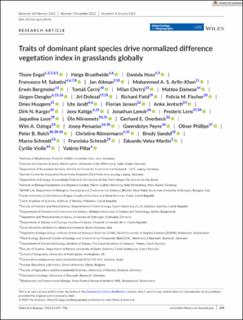Please use this identifier to cite or link to this item:
https://doi.org/10.21256/zhaw-28573| Publication type: | Article in scientific journal |
| Type of review: | Peer review (publication) |
| Title: | Traits of dominant plant species drive normalized difference vegetation index in grasslands globally |
| Authors: | Engel, Thore Bruelheide, Helge Hoss, Daniela Sabatini, Francesco M. Altman, Jan Arfin‐Khan, Mohammed A. S. Bergmeier, Erwin Černý, Tomáš Chytrý, Milan Dainese, Matteo Dengler, Jürgen Dolezal, Jiri Field, Richard Fischer, Felícia M. Huygens, Dries Jandt, Ute Jansen, Florian Jentsch, Anke Karger, Dirk N. Kattge, Jens Lenoir, Jonathan Lens, Frederic Loos, Jaqueline Niinemets, Ülo Overbeck, Gerhard E. Ozinga, Wim A. Penuelas, Josep Peyre, Gwendolyn Phillips, Oliver Reich, Peter B. Römermann, Christine Sandel, Brody Schmidt, Marco Schrodt, Franziska Velez‐Martin, Eduardo Violle, Cyrille Pillar, Valério |
| et. al: | No |
| DOI: | 10.1111/geb.13644 10.21256/zhaw-28573 |
| Published in: | Global Ecology and Biogeography |
| Volume(Issue): | 32 |
| Issue: | 5 |
| Page(s): | 695 |
| Pages to: | 706 |
| Issue Date: | May-2023 |
| Publisher / Ed. Institution: | Wiley |
| ISSN: | 1466-822X 1466-8238 |
| Language: | English |
| Subjects: | Biodiversity-ecosystem functioning; Biodiversity; Community-weighted mean; Ecosystem functioning; Functional diversity; sPlot; Trait; Vegetation |
| Subject (DDC): | 577: Ecology 580: Plants (Botany) |
| Abstract: | Aim: Theoretical, experimental and observational studies have shown that biodiversity–ecosystem functioning (BEF) relationships are influenced by functional community structure through two mutually non-exclusive mechanisms: (1) the dominance effect (which relates to the traits of the dominant species); and (2) the niche partitioning effect [which relates to functional diversity (FD)]. Although both mechanisms have been studied in plant communities and experiments at small spatial extents, it remains unclear whether evidence from small-extent case studies translates into a generalizable macroecological pattern. Here, we evaluate dominance and niche partitioning effects simultaneously in grassland systems world-wide. Location: Two thousand nine hundred and forty-one grassland plots globally. Time period: 2000–2014. Major taxa studied: Vascular plants. Methods: We obtained plot-based data on functional community structure from the global vegetation plot database “sPlot”, which combines species composition with plant trait data from the “TRY” database. We used data on the community-weighted mean (CWM) and FD for 18 ecologically relevant plant traits. As an indicator of primary productivity, we extracted the satellite-derived normalized difference vegetation index (NDVI) from MODIS. Using generalized additive models and deviation partitioning, we estimated the contributions of trait CWM and FD to the variation in annual maximum NDVI, while controlling for climatic variables and spatial structure. Results: Grassland communities dominated by relatively tall species with acquisitive traits had higher NDVI values, suggesting the prevalence of dominance effects for BEF relationships. We found no support for niche partitioning for the functional traits analysed, because NDVI remained unaffected by FD. Most of the predictive power of traits was shared by climatic predictors and spatial coordinates. This highlights the importance of community assembly processes for BEF relationships in natural communities. Main conclusions: Our analysis provides empirical evidence that plant functional community structure and global patterns in primary productivity are linked through the resource economics and size traits of the dominant species. This is an important test of the hypotheses underlying BEF relationships at the global scale. |
| URI: | https://digitalcollection.zhaw.ch/handle/11475/28573 |
| Related research data: | https://doi.org/10.25829/idiv.3534-q4ja39 |
| Fulltext version: | Published version |
| License (according to publishing contract): | CC BY 4.0: Attribution 4.0 International |
| Departement: | Life Sciences and Facility Management |
| Organisational Unit: | Institute of Natural Resource Sciences (IUNR) |
| Appears in collections: | Publikationen Life Sciences und Facility Management |
Files in This Item:
| File | Description | Size | Format | |
|---|---|---|---|---|
| 2023_Engel-etal_Dominant-plant-species-traits-driving-NDVI-in-grasslands.pdf | 1.58 MB | Adobe PDF |  View/Open |
Show full item record
Engel, T., Bruelheide, H., Hoss, D., Sabatini, F. M., Altman, J., Arfin‐Khan, M. A. S., Bergmeier, E., Černý, T., Chytrý, M., Dainese, M., Dengler, J., Dolezal, J., Field, R., Fischer, F. M., Huygens, D., Jandt, U., Jansen, F., Jentsch, A., Karger, D. N., et al. (2023). Traits of dominant plant species drive normalized difference vegetation index in grasslands globally. Global Ecology and Biogeography, 32(5), 695–706. https://doi.org/10.1111/geb.13644
Engel, T. et al. (2023) ‘Traits of dominant plant species drive normalized difference vegetation index in grasslands globally’, Global Ecology and Biogeography, 32(5), pp. 695–706. Available at: https://doi.org/10.1111/geb.13644.
T. Engel et al., “Traits of dominant plant species drive normalized difference vegetation index in grasslands globally,” Global Ecology and Biogeography, vol. 32, no. 5, pp. 695–706, May 2023, doi: 10.1111/geb.13644.
ENGEL, Thore, Helge BRUELHEIDE, Daniela HOSS, Francesco M. SABATINI, Jan ALTMAN, Mohammed A. S. ARFIN‐KHAN, Erwin BERGMEIER, Tomáš ČERNÝ, Milan CHYTRÝ, Matteo DAINESE, Jürgen DENGLER, Jiri DOLEZAL, Richard FIELD, Felícia M. FISCHER, Dries HUYGENS, Ute JANDT, Florian JANSEN, Anke JENTSCH, Dirk N. KARGER, Jens KATTGE, Jonathan LENOIR, Frederic LENS, Jaqueline LOOS, Ülo NIINEMETS, Gerhard E. OVERBECK, Wim A. OZINGA, Josep PENUELAS, Gwendolyn PEYRE, Oliver PHILLIPS, Peter B. REICH, Christine RÖMERMANN, Brody SANDEL, Marco SCHMIDT, Franziska SCHRODT, Eduardo VELEZ‐MARTIN, Cyrille VIOLLE und Valério PILLAR, 2023. Traits of dominant plant species drive normalized difference vegetation index in grasslands globally. Global Ecology and Biogeography. Mai 2023. Bd. 32, Nr. 5, S. 695–706. DOI 10.1111/geb.13644
Engel, Thore, Helge Bruelheide, Daniela Hoss, Francesco M. Sabatini, Jan Altman, Mohammed A. S. Arfin‐Khan, Erwin Bergmeier, et al. 2023. “Traits of Dominant Plant Species Drive Normalized Difference Vegetation Index in Grasslands Globally.” Global Ecology and Biogeography 32 (5): 695–706. https://doi.org/10.1111/geb.13644.
Engel, Thore, et al. “Traits of Dominant Plant Species Drive Normalized Difference Vegetation Index in Grasslands Globally.” Global Ecology and Biogeography, vol. 32, no. 5, May 2023, pp. 695–706, https://doi.org/10.1111/geb.13644.
Items in DSpace are protected by copyright, with all rights reserved, unless otherwise indicated.